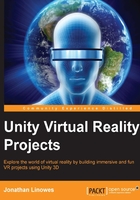
What this book covers
This book takes a practical, project-based approach to teach the specifics of virtual reality development using the Unity 3D game development engine. You'll learn how to use Unity 5 to develop VR applications, which can be experienced with devices such as the Oculus Rift or Google Cardboard.
However, we have a slight problem here—the technology is advancing very rapidly. Of course, this is a good problem to have. Actually, it's an awesome problem to have, unless you're a developer in the middle of a project or an author of a book on this technology! How does one write a book that does not have obsolete content the day it's published?
Throughout the book, I have tried to distill some universal principles that should outlive any near-term advances in virtual reality technology, that includes the following:
- Categorization of different types of VR experiences with example projects
- Important technical ideas and skills, especially the ones relevant to the building of VR applications
- General explanations on how VR devices and software works
- Strategies to ensure user comfort and avoid VR motion sickness
- Instructions on using the Unity game engine to build VR experiences
Once VR becomes mainstream, many of these lessons will perhaps be obvious rather than obsolete, just like the explanations from the 1980's on how to use a mouse would just be silly today.
Who are you?
If you are interested in virtual reality, want to learn how it works, or want to create VR experiences yourself, this book is for you. We will walk you through a series of hands-on projects, step-by-step tutorials, and in-depth discussions using the Unity 3D game engine.
Whether you're a non-programmer who is unfamiliar with 3D computer graphics, or a person with experience in both but new to virtual reality, you will benefit from this book. It is not a cold start with Unity, but you do not need to be an expert either. Still, if you're new to Unity, you can pick up this book as long as you realize that you'll need to adapt to the pace of the book.
Game developers may already be familiar with the concepts in the book, which are reapplied to the VR projects while learning many other ideas that are specific to VR. Engineers and 3D designers may understand many of the 3D concepts, but they may wish to learn to use the game engine for VR. Application developers may appreciate the potential non-gaming uses of VR and want to learn the tools that can make this happen.
Whoever you are, we're going to turn you into a 3D Software VR Ninja. Well, OK, this may be a stretch goal for this little book, but we'll try to set you on the way.